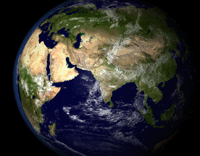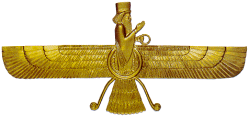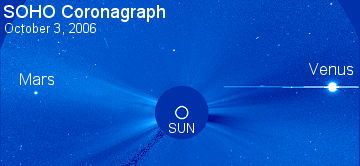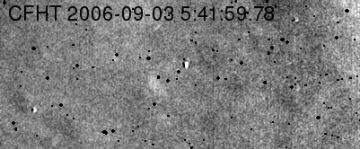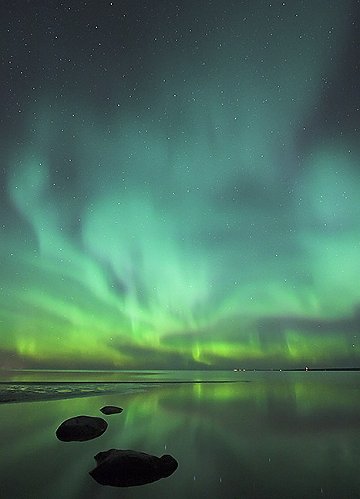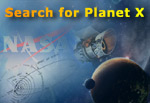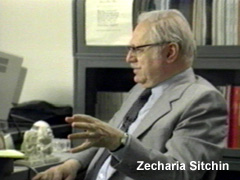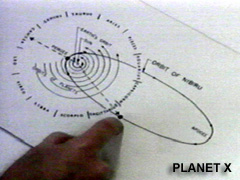![]()
Science, Space & Spirit

Archeologists in Burnt City
announced unprecedented discovery of an artificial
eyeball, dated to 4800 years ago, in this historic
site.
Announcing this news, director of Burnt City
archeology excavation team, Mansour Sajadi, said that
this eyeball belongs to a sturdy woman who was between
25 to 30 years of age at the time of death. Skeletal
remains of the woman were found in grave number 6705
of Burnt City's cemetery.
Regarding the material used to make this artificial
eyeball, Sajadi said: "The material this
artificial eyeball is made of has not yet been
determined and will be assessed through later testing.
However, at first glance it seems natural tar mixed
with animal fat has been used in making it."
Initial studies on the eyeball also suggest formation
of an abscess in the eyelid due to long-term contact
with the eyeball. Moreover, remaining eyelid tissues
are still evident on this artificial eyeball.
According to Sajadi, even the most delicate eye
capillaries were drawn on this eyeball using golden
wires with a thickness measuring less than half a
millimeter. There are also some parallel lines around
the pupil forming a diamond shape. Two holes are also
seen on the sides of this eyeball to hold it in the
eye socket.
Initial anthropological studies on the remaining
skeleton of the woman to which this artificial eyeball
belong revealed that she was a hybrid woman who died
4800 years ago between the ages of 25 to 30.
A number of clay vessels, ornamental beads, a leather
sack, and a bronze mirror have also been found in the
grave of this woman.
Located 57 kilometers from the city of Zabol in Sistan
va Baluchistan province, southeast Iran, Burnt City is
one of the most important prehistoric sites of the
country which was well developed during the third
millennium BC.
Spreading over a 300,000 hectare area, Burnt City was
recently recognized as mainland-Iran's largest
prehistoric site.
The city experienced four stages of civilization and
was burnt down three times, which is why it was named
"Burnt City."
Discovery of hundreds of historical sites including
166 satellite villages together with large numbers of
archeological relics, skeletons, and ancient
structures in the archeological site of Burnt City
makes it holder of an unparalleled record in the
history of archeological activities in Iran.
Space Information
|
What's Up
in Space --
COMET C/2006 T1 (LEVY): Proving that fancy CCD cameras are not required to discover comets, David H. Levy of Tucson, AZ, reports his visual discovery with a 0.41-m reflector of a diffuse comet close to Saturn in the sky: ephemeris. The new comet glows like a 10th magnitude star, making it an easy target for medium-to-large backyard telescopes. Ref: IAU Circular 8757. FULL DAWN MOON: When looking at the Moon, the best place to train your telescope is the day-night terminator, where the long shadows of lunar dawn create beautiful contrasts of light and dark. Consider the following: What would the Moon look like if it were dawn everywhere, all at once? Here is the answer: This unusual image was created by French photographer Ivan Goncalves. He made it by stitching together strips of dawn from photos he took of ten different lunar phases. Call it the "full Dawn Moon." The full Dawn Moon is the same Moon we see every month--same mountains, same craters, same lava seas. Yet it looks strangely different. Two nights from now the full Harvest Moon will appear. Save this photo and compare the two. CONVERGING PLANETS: Venus and Mars are converging on the sun. You can't see the event with the naked eye, but SOHO can. The spacecraft has a coronagraph onboard able to block the sun's glare and reveal nearby stars and planets: As October unfolds, Mars will approach the sun from the left, Venus from the right, eventually forming a compact triangle less than one degree wide. Dates of closest approach: Oct. 23rd - 27th. Mark your calendar and join SOHO for a ring-side seat. |
![]()
Potentially Hazardous Asteroids (PHAs)
are space rocks larger than approximately 100m that can come closer to Earth
than 0.05 AU. None of the known PHAs is on a collision course with our planet,
although astronomers are finding new
ones all the time.
there were 803
known Potentially
Hazardous Asteroids Aug-Sept
2006 Earth-asteroid encounters
| ASTEROID |
DATE |
MISS DISTANCE |
MAG. |
SIZE |
| 2006 QM111 |
Aug 31 |
0.4 LD |
21 |
13 m |
| 2006 QQ56 |
Sept. 2 |
7.9 LD |
18 |
29 m |
| 2006 QV89 |
Sept. 5 |
7.9 LD |
18 |
40 m |
It comes from the Sun!
The Sun is a big magnet.
During solar minimum the Sun's magnetic field, like Earth's, resembles that of an iron bar magnet, with great closed loops near the equator and open field lines near the poles. Scientists call such a field a "dipole." The Sun's dipolar field is about as strong as a refrigerator magnet, or 50 gauss. Earth's magnetic field is 100 times weaker.
 During
the years around solar maximum (2000 and 2001 are good examples) spots pepper
the face of the Sun. Sunspots are places where intense magnetic loops --
hundreds of times stronger than the ambient dipole field -- poke through the
photosphere. Sunspot magnetic fields overwhelm the underlying dipole; as a
result, the Sun's magnetic field near the surface of the star becomes tangled
and complicated.
During
the years around solar maximum (2000 and 2001 are good examples) spots pepper
the face of the Sun. Sunspots are places where intense magnetic loops --
hundreds of times stronger than the ambient dipole field -- poke through the
photosphere. Sunspot magnetic fields overwhelm the underlying dipole; as a
result, the Sun's magnetic field near the surface of the star becomes tangled
and complicated.
The Sun's magnetic field isn't confined to the immediate vicinity of our star. The solar wind carries it throughout the solar system. Out among the planets we call the Sun's magnetic field the "Interplanetary Magnetic Field" or "IMF." Because the Sun rotates (once every 27 days) the IMF has a spiral shape -- named the "Parker spiral" after the scientist who first described it.
Above: Steve Suess (NASA/MSFC) prepared this figure, which shows the Sun's spiraling magnetic field from a vantage point ~100 AU from the Sun.
Earth has a magnetic field, too. It forms a bubble around our planet called the magnetosphere, which deflects solar wind gusts. (Mars, which does not have a protective magnetosphere, has lost much of its atmosphere as a result of solar wind erosion.) Earth's magnetic field and the IMF come into contact at the magnetopause: a place where the magnetosphere meets the solar wind. Earth's magnetic field points north at the magnetopause. If the IMF points south -- a condition scientists call "southward Bz" -- then the IMF can partially cancel Earth's magnetic field at the point of contact.

Above: Earth's magnetosphere. From the Oulu Space Physics Textbook.
"When Bz is south, that is, opposite Earth's magnetic field, the two fields link up," explains Christopher Russell, a Professor of Geophysics and Space Physics at UCLA. "You can then follow a field line from Earth directly into the solar wind" -- or from the solar wind to Earth. South-pointing Bz's open a door through which energy from the solar wind can reach Earth's atmosphere!
Southward Bz's often herald widespread auroras, triggered by solar wind gusts or coronal mass ejections that are able to inject energy into our planet's magnetosphere.
there were 803
known Potentially
Hazardous Asteroids Aug-Sept
2006 Earth-asteroid encounters
| ASTEROID |
DATE |
MISS DISTANCE |
MAG. |
SIZE |
| 2006 QM111 |
Aug 31 |
0.4 LD |
21 |
13 m |
| 2006 QQ56 |
Sept. 2 |
7.9 LD |
18 |
29 m |
| 2006 QV89 |
Sept. 5 |
7.9 LD |
18 |
40 m |
On 5 Sep 2006 there
were 803
known Potentially
|
| Essential Web Links |
|
NOAA Space Environment Center -- The official U.S. government bureau for real-time monitoring of solar and geophysical events, research in solar-terrestrial physics, and forecasting solar and geophysical disturbances. Atmospheric Optics -- the first place to look for information about sundogs, pillars, rainbows and related phenomena. See also Snow Crystals. Solar and Heliospheric Observatory -- Realtime and archival images of the Sun from SOHO. (European Mirror Site) Daily
Sunspot Summaries -- from the
NOAA Space Environment Center. Recent Solar Events -- a nice summary of current solar conditions from lmsal.com. List of Potentially Hazardous Asteroids -- from the Harvard Minor Planet Center. Observable Comets -- from the Harvard Minor Planet Center. What is the Interplanetary Magnetic Field? -- A lucid answer from the University of Michigan. See also the Anatomy of Earth's Magnetosphere. Real-time Solar Wind Data -- from NASA's ACE spacecraft. How powerful are solar wind gusts? Read this story from Science@NASA. More Real-time Solar Wind Data -- from the Solar and Heliospheric Observatory Proton Monitor. Lists of Coronal Mass Ejections -- from 1998 to 2001 Mirages: Mirages in Finland; An Introduction to Mirages; NOAA Solar Flare and Sunspot Data: 1996, 1997, 1998, 1999; 2000; 2001; 2002; 2003; 2004; 2005; Jan-Mar 2006; Space Audio Streams: (University of Florida) 20 MHz radio emissions from Jupiter: #1, #2, #3, #4; (NASA/Marshall) INSPIRE: #1; (Stan Nelson of Roswell, New Mexico) meteor radar: #1, #2; |
August 27 HOAX TheRedPlanet1.pps
Space Weather News for August 6, 2006
MARS HOAX: A bogus email is going around the Internet. It claims that Mars will be historically close to Earth on August 27, 2006--so close that Mars will look as large as the full Moon. This is not true. Here are the facts: On August 27th, Mars will be on the other side of the solar system, about 385 million kilometers from Earth. The red planet will look tiny and dim, nothing like a full Moon.
The "Mars Hoax" email first appeared in 2003. On August 27th of that year, Mars really did come historically close to Earth. But the email's claim that Mars would rival the Moon was grossly exaggerated. Every August since 2003, the email has staged a revival. It's as wrong now as it was then.
SUNNY SATURN: Looking for Saturn? Don't. It could hurt your eyes. This weekend Saturn is passing right by the Sun. See images of the close encounter at http://Spaceweather.com
![]()
Potentially Hazardous Asteroids (PHAs)
are space rocks larger than approximately 100m that can come closer to Earth
than 0.05 AU. None of the known PHAs is on a collision course with our planet,
although astronomers are finding new
ones all the time.
On 6 Aug 2006 there were 800
known Potentially
Hazardous Asteroids July 2006
Earth-asteroid encounters
| ASTEROID |
DATE |
MISS DISTANCE |
MAG. |
SIZE |
| 2004 XP14 |
Jul 3 |
1.1 LD |
12 |
600 m |
| 2006 BQ6 |
Jul 29 |
14 LD |
16 |
500 m |
NASA Science News A small spacecraft named LCROSS will hitch a ride to the moon in 2008. Its mission: to hit the moon near the lunar south pole and look for signs of water among the debris.
FULL STORY at http://science.nasa.gov/headlines/y2006/10apr_lcross.htm?list35384
Space Weather News http://spaceweather.com
Dying comet 73P/Schwassmann-Wachmann 3 continues to break apart.
Astronomers are tracking at least 20 fragments approaching Earth for a harmless
but beautiful close encounter in May. In particular, fragment B of the comet has brightened 15-fold since April
2nd. This signals a possible breakup of "73P-B" into even more
fragments. Amateur astronomers with backyard telescopes and CCD cameras can
monitor the ongoing disintegration.
NASA Science News NASA's Spitzer Space Telescope has found a disk of dusty debris surrounding a long-dead star. It is the kind of disk where planets are born, raising the possibility that second-generation planets can form around stars after they go supernova. FULL STORY at
http://science.nasa.gov/headlines/y2006/05apr_pulsarplanets.htm?list35384
Sky maps:
Comet fragment ephemerides -- from JPL
The τ Herculid meteor shower and Comet 73P/Schwassmann–Wachmann 3
The story says, "In May 2006 the fragments are going to fly past Earth closer than any comet has come in almost eighty years." What was the comet that came closer almost eighty years ago? Answer: 7P/Pons-Winnecke, which flew past Earth at a distance of 3.6 million miles on June 26, 1927. Comet 7P/Pons-Winnecke was small and faint in spite of being nearby; it glowed like a 3rd or 4th magnitude star, about as bright as the larger fragments of 73P will be in May 2006.
Comet 73P/Schwassmann–Wachmann 3 -- a history of observations
Comet 3D/Biela -- a comet that broke apart in 1846 and subsequently produced three strong meteor showers.
NASA Science News
A cometary "string-of-pearls" will fly past Earth
in May 2006 giving astronomers a fantastic view of a comet in its death
throes. FULL STORY at http://science.nasa.gov/headlines/y2006/24mar_73p.htm?list35384
Space Weather News WEEKEND AURORAS: A solar wind stream hit Earth on March 18th, sparking a
geomagnetic storm and auroras over northern US states such as Wisconsin,
Minnesota and Michigan. It's no coincidence that auroras are showing up now--on
the eve of Northern Spring. History shows that weeks around the equinoxes are
often good times to catch Northern Lights. Visit http://spaceweather.com for
more information and pictures of this weekend's auroras.
NASA astronauts are going back to the moon and when they get there they may need quake-proof housing. The moon is shaking with "shallow moonquakes" that researchers don't fully understand.
FULL STORY at http://science.nasa.gov/headlines/y2006/15mar_moonquakes.htm?list35384
Space Weather News MERCURY AT ITS BEST: Tonight is the best night
of the year to see Mercury. Step outside at sunset and look west. Mercury is the
bright pink "star" shining through the glow of the setting sun. (If
you miss the planet tonight, try again tomorrow. Mercury will remain visible at
sunset all weekend long.) NEW COMET: A new comet is emerging in the
morning sky. Comet Pojmanski has been brightening since its discovery in January
and can now be found just east of Venus before sunrise. The best way to see the
comet is through binoculars or a small telescope: It looks like a fuzzy
5th-magnitude star with a small tail. visit paceweather.com for sky maps and
more information. Space Weather News ALIEN LIGHTNING: NASA's Cassini spacecraft is
tracking an intense lightning storm on Saturn. The powerful bolts are causing
the spacecraft's radio instruments to "crackle"--much like the
crackles you might hear coming from your car's AM radio when you drive by a
thunderstorm on Earth. Visit http://spaceweather.com to listen to the sounds of
Saturn's lightning. 400-YEAR OLD SUNSPOTS: Today is the 442nd
birthday of Galileo Galilei, a figure of importance in the history of space
weather. Contrary to popular belief, Galileo didn't discover sunspots, but he
was one of the first to observe them using a telescope and he discovered many of
their basic properties. Visit http://spaceweather.com to learn more about
Galileo's pioneering work and to see actual drawings of sunspots he made more
than four centuries ago.
Space Weather News SUITSAT: astronauts plan to hurl an
old spacesuit overboard from the International Space Station. The
disembodied suit, nicknamed "SuitSat," will proceed to circle Earth,
transmitting a radio message which anyone can hear using a police scanner or a
ham radio tuned to 145.990 MHz FM. This strange experiment is a test of a
sensible idea--that old spacesuits might be transformed into useful satellites.
Would you like to listen to SuitSat? Sign up for Spaceweather PHONE http://spaceweatherphone.com
and you'll receive alerts when the suit is about to orbit over your area. MUST-SEE VIDEOwhen the Stardust capsule
ripped through Earth's atmosphere en route to a parachute landing in
Utah, no one had a better view than scientists onboard NASA's DC-8 Airborne
Laboratory, and they recorded a spectacular video. In addition to the man-made
fireball (Stardust) there are at least two natural meteors in the video. See
them all at http://spaceweather.com CLOSE ENCOUNTER WITH SATURN: On Friday, Jan. 27th,
Saturn will be at its closest to Earth for all of 2006. Even a small telescope
will show the planet's exquisite rings. Look for Saturn rising in the east at
sunset (it looks like a bright yellow star) and soaring overhead at midnight.
Bad weather on Friday? Don't worry. Saturn will remain close to Earth for weeks
to come. You'll have many more chances to see the ringed planet at its best.
Visit Spaceweather.com for details and a sky map. BIG SUNSPOT: Sunspot 848 burst through the surface of the sun last week and
quickly grew into a planet-sized behemoth. (Which planet? Coincidentally,
Saturn.) Now it is falling apart. The rise and fall of this big 'spot is shown
in a movie on Space
A very strange satellite is about to go into Earth orbit. It's "SuitSat," an empty spacesuit thrown overboard from the International Space Station. Using a simple police scanner or ham radio, you can listen to SuitSat when it orbits over your hometown.
FULL STORY at
http://science.nasa.gov/headlines/y2006/26jan_suitsat.htm?list35384
NASA Science News
The ski report is
out of this world: clear skies, no wind and deep powder. We're
talking about the moon. FULL STORY at http://science.nasa.gov/headlines/y2006/17jan_jack.htm?list35384
FIREBALL ALERT: On Sunday
morning, Jan. 15th, between approximately 1:56 and 1:59 a.m. PST (0956 -
0959 UT), a brilliant fireball will streak over northern California and Nevada.
It's NASA's Stardust capsule, returning to Earth with samples of dust from Comet
Wild 2. Observers along the flight path should have a marvelous view of this
rare man-made meteor. Radio signals reflected from the capsule's ionized tail
may be heard from a much wider area--hundreds to thousands of miles away. Visit http://spaceweather.com
Fascinating Universe
Infrared Helix

for maps and observing tips.
INTERNATIONAL SPACE STATION: The International Space Station is flying over the United States in mid-January during evening hours when it is easy to see. Would you like a phone call to alert you when the station is about to appear over your home town? http://spaceweatherphone.com
NASA Science News for January 3, 2006
Astronauts have noticed something strange about shadows on the moon.
FULL STORY at
http://science.nasa.gov/headlines/y2006/03jan_moonshadows.htm?list35384
Find out about the Science@NASA Podcast feed at http://science.nasa.gov/podcast.htm .
NASA Science News for January 3, 2006
Aurora Mega-Gallery
Space Weather News for Dec. 29, 2005
AURORA MEGA-GALLERY: We've collected every aurora photo ever published on SpaceWeather.com into one "mega-gallery." There are spooky auroras, man-made auroras, auroras in Florida, auroras at the South Pole, auroras beneath the space shuttle--thousands of photos. Together, they are a unique chronicle of space weather since the year 2000. Browse the collection at http://www.spaceweather.com/aurora/gallery.html
NEW YEAR'S MOON: There's going to be an unusual New Moon on Dec. 31, 2005. It's the second New Moon in less than a month. When there are two *Full* Moons in a month, we give the second one a special name, "Blue Moon." Maybe the second *New* Moon should have a special name, too. SpaceWeather readers have made their suggestions, and we've picked a favorite. Visit http://spaceweather.com for the full story.
This photo is a very rare one, taken by NASA.
This kind of event occurs once in 3000 years.
This photo has done miracles in many lives.
Make a wish... you have looked at the eye of God.
Surely you will see the changes in your life within a day.
This is a picture NASA took with the hubble telescope.
Called "The Eye of God".
NASA Science News
NASA plans to put a laser in orbit around the Moon to map its surface for future explorers.
FULL STORY at http://science.nasa.gov/headlines/y2005/24may_lola.htm?list35384
Using NASA's Hubble Space Telescope, astronomers have discovered that Pluto may have not one, but three moons.
FULL STORY at http://science.nasa.gov/headlines/y2005/01nov_moonsofpluto.htm?list35384
Researchers are developing advanced computers that can think clearly even when they're bombarded by space radiation.
FULL STORY at http://science.nasa.gov/headlines/y2005/18nov_eaftc.htm?list35384
How do you put troublesome moondust to good use? Simple. All it takes is a lunar lawn mower.
FULL STORY at http://science.nasa.gov/headlines/y2005/09nov_lawnmower.htm
Astronauts on the Moon will be exposed to cosmic rays and solar flares--and that's not all: the Moon itself can be a source of radiation. NASA is sending a robotship to the Moon to measure exactly how much radiation awaits human explorers.
FULL STORY http://science.nasa.gov/headlines/y2005/08sep_radioactivemoon.htm?list35384
|
I Early
depiction of the Wheel
This
agate cylinder seal is engraved with a scene showing the Persian king
standing in a chariot and shooting arrows at lions. The scene is
framed by date palms and above the king's head floats a figure in a
winged disc, who is usually thought to be the Persian god Ahura-Mazda,
but who may represent the spirit of the dead king or divine glory (khvarneh
or farr) that was bestowed on the living ruler.
The cuneiform inscription written along one side is in three
languages: Old Persian, Elamite and Babylonian, and translates 'Darius
the great king'. This is presumably Darius I (reigned 521-486 BC) who
reorganized the administration of the Persian Empire and was the first
Persian king to mint coins. He also introduced cuneiform for recording
inscriptions in Old Persian and built a canal linking the Nile with
the Red Sea. During Darius' reign, Egypt was part of the Persian
Empire with its former capital at Memphis now a seat of Persian
administration. This seal is said to have been found in a tomb at
Thebes which was the cemetery of Memphis. It is the most famous
Persian-period object found in Egypt. J. Curtis, Ancient Persia (London, The British Museum Press,
2000), p. 58, fig. 64
it
moves while you're putting it together. This
is amazing how it works while it is moving all the time.
|
Science, Space & Spirit
coming soon (under construction )
Planet X / Nibiru / Just the facts...
|
Where is the proof? This is usually the first questions people ask when presented with the idea that Aliens exist, or that we have been visited in the past by ancient astronauts. When a person does gain enough interest to start looking into topics such as Aliens and Ufos, they must wade through a vast amount of information. I have spent over a decade researching various areas of Ufology. My first interest in Ufology, was sparked by the structures on Mars, and NASA's explanation for the Cydonia region of Mars. Are the "Face" and "Pyramids" on Mars connected with the ancient Pyramids and Sphinx in Egypt? This led me to look into many other Megalithic Monuments around the world that are still here today from previous civilizations. Some of the structures including Giza, display architectural and mathematical achievements still unmatched to this day!
Planet X / Nibiru - What is the difference? The term "Nibiru" comes from the Sumerian cuneiform stone tablets and writings that are 6,000 years old. The term Nibiru means "Planet of the crossing". The Sumerian culture is the first recorded civilization on earth, then called Sumerian, today's Iraq. It has been known throughout ensuing time periods as Sumer, Mesopotamia, and Babylon, all the same location for where earth's first culture shows up on earth. The Sumerian Culture is the oldest known civilization we know of based on the artifacts and monuments that still remain.
Stories throughout the english version of the bible, today's modern version, speak of many events that changed the coarse of humanity in our past. If we look at the stories in the bible as historical accounts of what actually took place, then we need to research the origins of these stories. The hebrew version of the bible, known as the Old Testament, which is a much older version than the english translation, is derived from the stories of the Sumerian Culture. When we trace the origins of the Old testament we can see that it is also based on previous translations from subsequent older languages throughout history. The Sumerian culture, the first civilization to invent writing as a complete written language, recorded stories that have been preserved through the modern day biblical passages found in the Old and New testament. All of which speak of a time when man lived among their living gods here on earth. The Sumerians had 7 sacred tablets that explained our creation. These stories preserved in stone, are now told to us in the form of the english version, "7 days of creation". They also had a story of a great flood, and how one of the Gods choose to give a certain Sumerian man knowledge on how to build a boat that could withstand the great flood. All the stories in the bible are just translated versions of the original Sumerian Texts that we still have today preserved in stone, unchanged. The Sumerians tell us that their Gods, taught them all the amazing knowledge that the Sumerian Culture possessed, 6,000 years ago. They called their Gods, "anunnaki" which is translated to mean "those who from heaven to earth came"..
They have left us artifacts and stone tablet pictures that say the anunnaki came from another planet within our own solar system. They call this planet "Nibiru" which is where the anunnaki come from, according to the Sumerian translations. The Sumerians say that the anunnaki live on Nibiru, which has a 3,600 year orbit around our sun. All the other information they state including the color of the outer planets, and even the distance between the planets, has been proven to be accurate. We sent space probes out in the 70's that took the first pictures in color, which confirmed the Sumerian descriptions. The Sumerians were the first to invent over 100 of the first's for a modern culture. All academic references to the origins of writing, math, science, medicine, astronomy, lead to the Sumerian Culture and their amazing artifacts. We still use their math, medicine, science, time, music, astronomy, and many other fields, even to this day. Sumerian
Astronomy translations
The term "Planet X" refers to the search for another planet beyond Pluto through mainstream scientific efforts. The space probes sent out by NASA, mainly Voyager, and Pioneer, detected perturbations in the outer planets which suggested that there is still another planet, or heavenly body beyond Pluto that is affecting the orbits of the outer planets. Some of the latest public knowledge about this research done by NASA was conducted by Dr. Richard Harrington, who was the lead astronomer at NASA's Naval Observatory in Washington. (now deceased)
The Planet X searched for by astronomers during the last two or three decades is the planet that was believed to be affecting the orbit of Neptune - once the effects of Uranus on Neptune had been taken into account. Lowell and several other astronomers made extensive searches and calculations in the region of sky that they had calculated as the position for the missing planet. Then, Sept 30, 1846 --- one week after the discovery of Neptune, Le Verrier declared that there may be still another unknown planet out there. On October 10, Neptune's large moon Triton was discovered, which yielded an easy way to accurately determine the mass of Neptune, which turned out to be 2% larger than expected from the perturbations upon Uranus. Finally, astronomer Tombaugh found Pluto in 1930 - albeit six degrees away from the calculated point of their search for another planet beyond Neptune at that time. It was quickly realized that Pluto was too small to have the supposed gravitational effect on Neptune, and so the search went on beyond Pluto, for yet one more missing planet, that we know call Planet X. Dr.
Harrington's NASA archived Research |
 |
|
|
TIME LINE OF RESEARCH REGARDING THE "SEARCH FOR PLANET X"
- In 1841, John Couch Adams began investigating the by then quite large residuals in the motion of Uranus. In 1845, Urbain Le Verrier started to investigate them, too. Adams presented two different solutions to the problem, assuming that the deviations were caused by the gravitation from an unknown planet.
- Sept 30, 1846 --- one week after the discovery of Neptune, Le Verrier declared that there may be still another unknown planet out there. On October 10, Neptune's large moon Triton was discovered, which yielded an easy way to accurately determine the mass of Neptune, which turned out to be 2% larger than expected from the perturbations upon Uranus.
- Another attempt to find a trans-Neptunian planet was done in 1877 by David Todd. He used a "graphical method", from the residuals of Uranus, he derived elements for a trans-Neptunian planet: mean distance 52 a.u., period 375 years, magnitude fainter than 13.
- In 1879, Camille Flammarion added another hint as to the existence of a planet beyond Neptune: the aphelia of periodic comets tend to cluster around the orbits of major planets. Jupiter has the greatest share of such comets, and Saturn, Uranus and Neptune also have a few each.
- Percival Lowell, most well known as a proponent for canals on Mars, built a private observatory in Flagstaff, Arizona. Lowell called his hypothetical planet Planet X, and performed several searches for it, without success. Lowell's first search for Planet X came to an end in 1909, but in 1913 he started a second search, with a new prediction of Planet X: epoch 1850-01-01, mean long 11.67 deg, perih. long 186, eccentricity 0.228, mean dist 47.5 a.u. long arc node 110.99 deg, inclination 7.30 deg, mass 1/21000 solar masses. Lowell and others searched in vain for this Planet X in 1913-1915. In 1915, Lowell published his theoretical results of Planet X. It is ironic that this very same year, 1915, two faint images of Pluto was recorded at Lowell observatory, although they were never recognized as such until after the discovery of Pluto (1930).
Something out there beyond the farthest reaches of the known solar system seems to be tugging at Uranus and Neptune. Some gravitational force keeps perturbing the two giant planets, causing irregularities in their orbits. The force suggests a presence far away and unseen, a large object that may be the long- sought Planet X. The last time a serious search of the skies was made it led to the discovery in 1930 of Pluto, the ninth planet. But the story begins more than a century before that, after the discovery of Uranus in 1781 by the English astronomer and musician William Herschel. Until then, the planetary system seemed to end with Saturn.Today, scientists accept theories concerning plate tectonics. There are articles and studies showing that, at one time, all of Earth continents were on one side of the planet. What the stories don't explore is the question, if all the continents were on one side, what was on the other? The other side has been described as a tremendous gap, matching the Sumerian story of how the Earth came about. The Sumerians said Earth was really half a planet called Tiamat, which broke up in a collision with Nibiru, [or Planet X].
THE SEARCH FOR PLANET X - VIDEO LECTURE
New York Times
June 19, 1982The discovery of new planets has, in the last two hundred years, owed more to the science of mathematics than it has to the design of bigger and better telescopes. The unaccounted-for mathematical irregularities in the orbits of the outer planets have prompted astronomers to speculate upon the existence of a further, undiscovered planet. Astronomers are so certain of this planet's existence that they have already named it 'Planet X' - the Tenth Planet.
NASA themselves officially recognized the possibility of Planet X, with an announcement that 'some kind of mystery object is really there - far beyond the outermost planets'. One year later, the newly launched IRAS (Infrared Astronomical Satellite) spotted a large mysterious object in the depths of space.
To this day, the search continues for a PLANET X. One day soon we just might find a planet that matches the Sumerian descriptions for a planet 4-8 times the size of earth, on a highly 3,600 elliptical orbit around our sun. Continue to "page 3" to learn more....
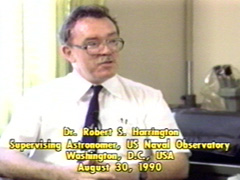
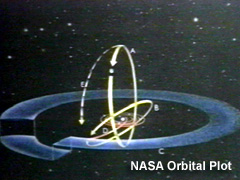
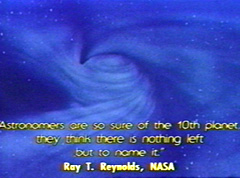
INTERVIEW
AT
NASA
ABOUT
PLANET
X
|
In the early 1990's, calculations by the United States Naval Observatory have confirmed the orbital perturbation exhibited by Uranus and Neptune, which Dr. Thomas C Van Flandern, an astronomer at the observatory, says could be explained by "a single undiscovered planet". He and a colleague, Dr. Robert Harrington, calculate that the 10th planet should be two to five times more massive than Earth and have a highly elliptical orbit that takes it some 5 billion miles beyond that of Pluto. We know today that beyond the giant planets Jupiter and Saturn lie more major planets, Uranus and Neptune, and a small planet, Pluto. But such knowledge is quite recent. Uranus was discovered, through the use of improved telescopes, in 1781. Neptune was pinpointed by astronomers (guided by mathematical calculations) in 1846. It became evident that Neptune was being subjected to unknown gravitational pull, and in 1930 Pluto (was located). The latest advances in space imaging do not rely solely on orbital perturbations as the way for locating and identifying possible candidates for Planet X. The 6,000 year old Sumerian descriptions of our solar system include one more planet they called "Nibiru", which means "Planet of the crossing".The descriptions of this planet by the Sumerians match precisely the specifications of "Planet X" (the Tenth Planet), which is currently being sought by astronomers in the depths of our own Solar System. Why has Planet X not been seen in recent times? Views from modern and ancient astronomy, which both suggest a highly elliptical, comet-like orbit, takes Planet X into the depths of space, well beyond the orbit of Pluto. We discovered Pluto with our telescopes just recently in 1930. Is it not possible that there are other forces at work on our solar system besides the nine planets we know of? YES!!!! The Sumerian descriptions of Our Solar System are being confirmed with modern advances in science. This article will show actual diagrams from the Sumerian times and how the accuracy for describing the planets is overwhelming!
|
|
 |
This
agate cylinder seal is engraved with a scene showing the Persian king
standing in a chariot and shooting arrows at lions. The scene is
framed by date palms and above the king's head floats a figure in a
winged disc, who is usually thought to be the Persian god Ahura-Mazda,
but who may represent the spirit of the dead king or divine glory (khvarneh
or farr) that was bestowed on the living ruler.
The cuneiform inscription written along one side is in three
languages: Old Persian, Elamite and Babylonian, and translates 'Darius
the great king'. This is presumably Darius I (reigned 521-486 BC) who
reorganized the administration of the Persian Empire and was the first
Persian king to mint coins. He also introduced cuneiform for recording
inscriptions in Old Persian and built a canal linking the Nile with
the Red Sea. During Darius' reign, Egypt was part of the Persian
Empire with its former capital at Memphis now a seat of Persian
administration. This seal is said to have been found in a tomb at
Thebes which was the cemetery of Memphis. It is the most famous
Persian-period object found in Egypt.
Now, THIS is
really
fascinating -
it's rather
dazzling to see
it presented
this way.
من فکر می کردم
خورشید نورانی
ترین ستاره در
جهان است.. در
تصویر زیر خورشید
را به ستاره های
دیگر مقایشه
کنید.
هم اکنون در
تصویر زیر به دقت
بنگرید
این عکس را
تلسکوپ هابل توسط
اشعه مادون قرمز
گرفته است.
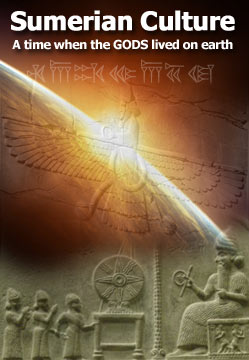
آنتارس جزء
پانزدهمین ستاره
های بزرگ است.
این ستاره 1000
سال نوری از ما
فاصله دارد.
آن را با خورشید
مقایسه کنید.
این تصویر تکه ای
از تاریک ترین
نقطه در تصویر
بالاست.
چه دنیای عظیمی
است نه؟
شما چقدر بزرگ
هستید؟
و مواردی که باعث
رنجش شما در این
دنیا هستند چقدر
بزرگند؟
زندگی را خیلی
سخت نگیرید... به
دنیایی بندیشید
که چقدر عظیم است
و غم ها و غصه
های ما که در
برابر این عظمت
چقدر کوچکند..!!

